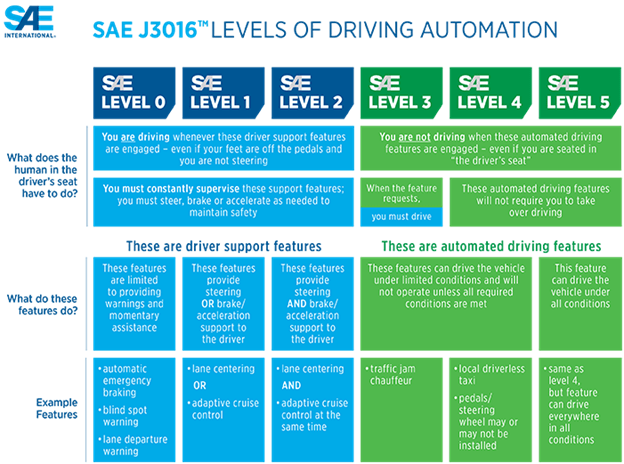Self-driving cars are no longer limited to sci-fi fantasies—autonomous vehicle technology has exploded over the past two decades, setting the foundation for a self-driving renaissance.
"Self-driving vehicles" is an umbrella term that covers several different kinds of vehicles. Distinguishing between them is critical for consumer, commercial and industrial users alike. We'll define self-driving car technology in the modern era and explore existing and theoretical self-driving car technologies.
5 Levels of Autonomous Driving
There is no binary way to determine whether a vehicle is "self-driving" or not. Instead, self-driving vehicles come in multiple levels, all of which help shape our understanding of how humans and vehicles interact to pilot a vehicle. The Society of Automotive Engineers' driving automation scale should help you understand what kinds of vehicles fall under the "self-driving" umbrella.

Image Credit: Society of Automotive Engineers
Level 0: Think of your dad's old Mustang or any vehicle built between the iconic Model T and 1994. Level 0 autonomy has no autonomy or self-driving ability, whatsoever.
Level 1: In 1995, Mitsubishi unveiled the first adaptive cruise control in a limited release of their Diamante model. Adaptive cruise control—cruise control that intuitively accelerates and brakes depending on proximity to other cars—is considered the first step in self-driving technology. A vehicle has level 1 autonomy if it has a system that assists the driver while they pilot the vehicle.
Level 2:Level 2 autonomy is the vehicle's ability to automate tasks, such as navigating and accelerating around a slow vehicle, steering and piloting a vehicle on a highway, or automatically parallel parking.
One of the first examples of level 2 autonomy in consumer vehicles is Toyota's Intelligent Parking Assist System (IPAS), which debuted in 2003. IPAS became commonplace in many Toyota and Lexus vehicles by 2006. As of 2020, Level 2 autonomous vehicles are common, and many automobile manufacturers sell vehicle models that perform Level 2 autonomy tasks like lane assist and collision avoidance.
Level 3: There is a large technological gap between Level 2 and Level 3 autonomy. Level 3 vehicles must have systems capable of controlling every aspect of driving under certain conditions, as well as the ability to understand them. In 2020, the most advanced, state-of-the-art self-driving vehicles fall into Level 3 autonomy.
At this level, the driver does no actual driving. Instead, they monitor the car's ability to drive in certain conditions. Level 3 autonomy requires that the car understands, processes, and adjusts its course according to actively changing conditions. The conditional driving nature of Level 3 autonomous vehicles requires a significantly different approach to vehicle control than Level 2 autonomous vehicles, such as the AI computers found in Tesla vehicles.
Currently, most vehicles with Level 3 autonomy utilize autonomy "modes," where a user can select whether they want to engage autonomous driving. To use autonomous mode, the vehicle must be in a simple driving scenario, such as driving on the highway or navigating streets. Of course, the driver can always intervene, if necessary.
SOTU of Level 3 Autonomous Vehicles: Tesla's Autopilot system has received significant acclaim for its autonomous driving capabilities, and all Tesla models built since October 2016 come standard with the Autopilot hardware, which is capable of level 3 autonomous driving. Tesla's Autopilot is powered by HD cameras surrounding the car and highly advanced AI-powered image processing.
Cadillac's Super Cruise, which was introduced in select models in 2018, boasts hands-free driving on select highways across the country. Using cameras, sensors, GPS, Wi-Fi, and several other systems, Super Cruise enables configurable adaptive cruise control and lane centering, which also enables hands-free steering.
Car manufacturers like BMW, Audi, Porsche, Ford, Lexus, Toyota and Honda are actively pursuing Level 3 self-driving systems and beyond. BMW claims that they will have hands-free driving by 2021.
Level 4: As we venture into the currently theoretical levels of autonomous driving, the driver becomes significantly less important. Level 4 autonomy is what many consider "fully self-driving," though the driver would still need some level of interaction with the car, such as robo-taxis. Level 4 autonomy is no longer as far-fetched as we once believed, and some companies, including Tesla, claim their current onboard computers can support Level 4 autonomy, barring future software updates.
However, social hesitations are a significant barrier to the adoption of Level 4 autonomy may. In a recent poll of over 2,000 people, less than 40% of people said they would feel somewhat comfortable or better with a fully automated driving experience. And only 6% said they would be "very likely" to buy a fully self-driving car.
Level 5: Perhaps only theoretical, Level 5 autonomy enables a vehicle to drive anywhere, in all conditions, without the need for a driver at all. This level of autonomy may only ever be realized in military and industrial settings, as consumer vehicles don't need to be able to drive in most extreme or off-road conditions. At this point, Level 5 autonomy seems to still be in its conceptual phase.
The Future of Self-Driving Cars
Autonomous driving vehicle technology has made large strides in the last five years, but the automotive industry is shaping up for a revolution. Once we reach Level 4 autonomy, new business models will emerge for automotive transport as an industry. Robo-taxi businesses like Waymo have already begun testing the future of ride-hailing services. The world of automotive transportation will never be the same once the technology meets the desire for fully autonomous driving.



